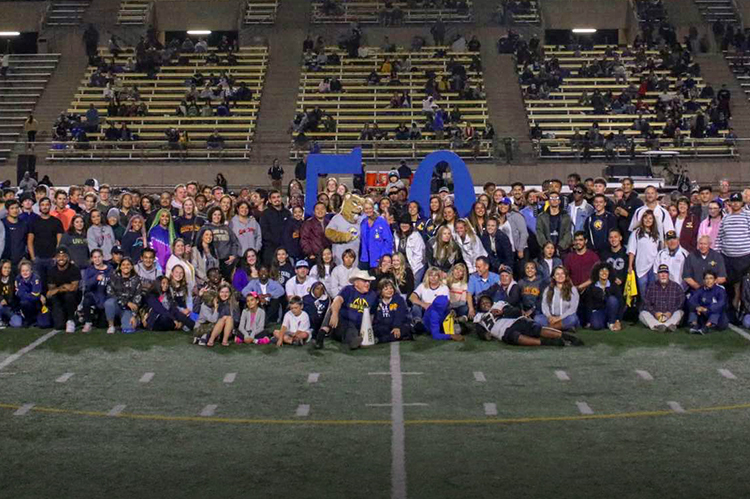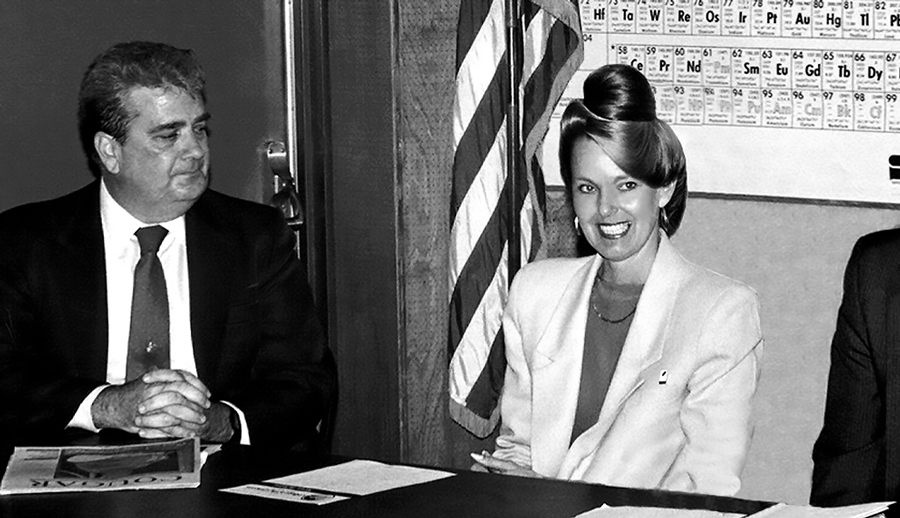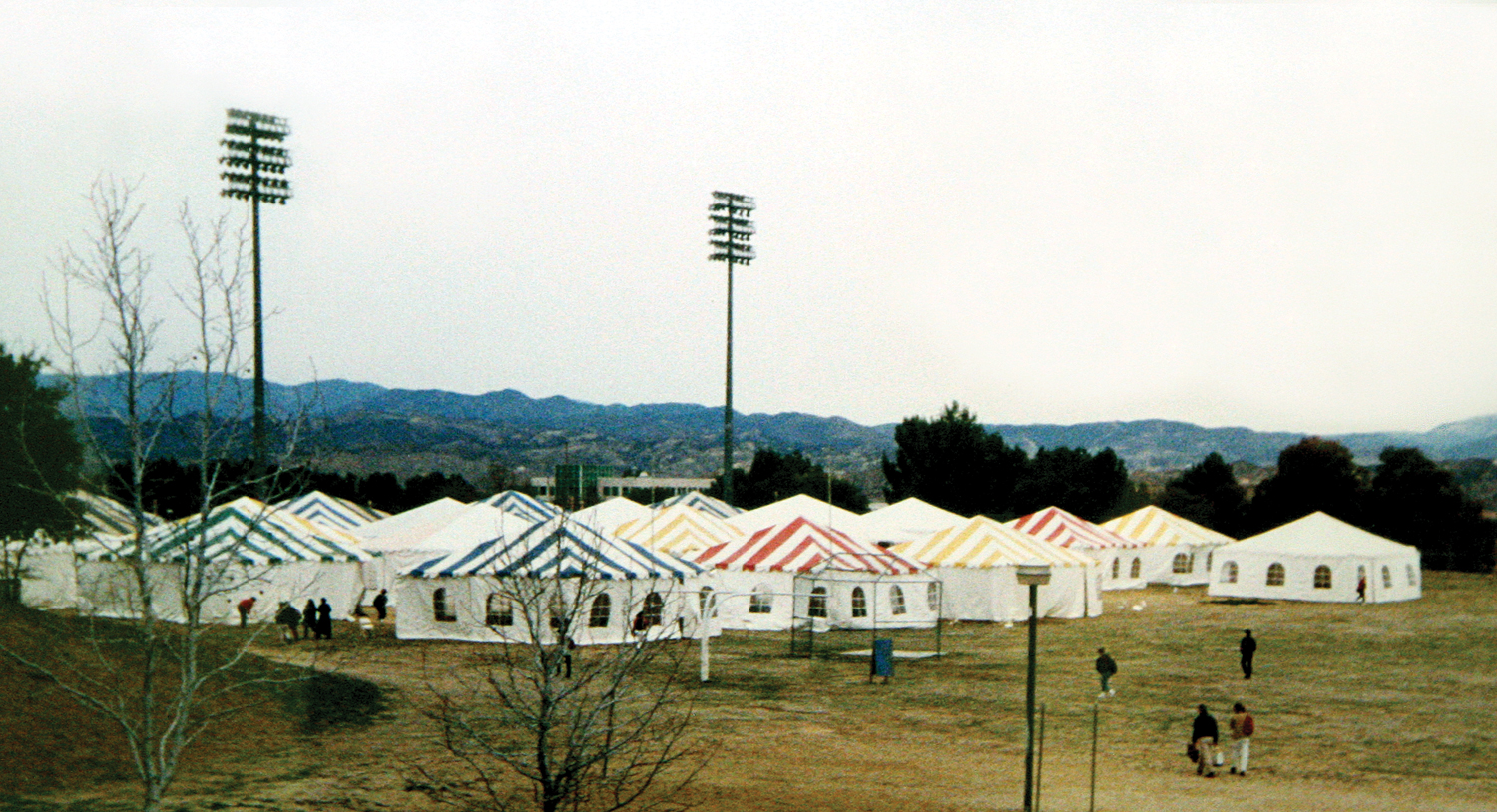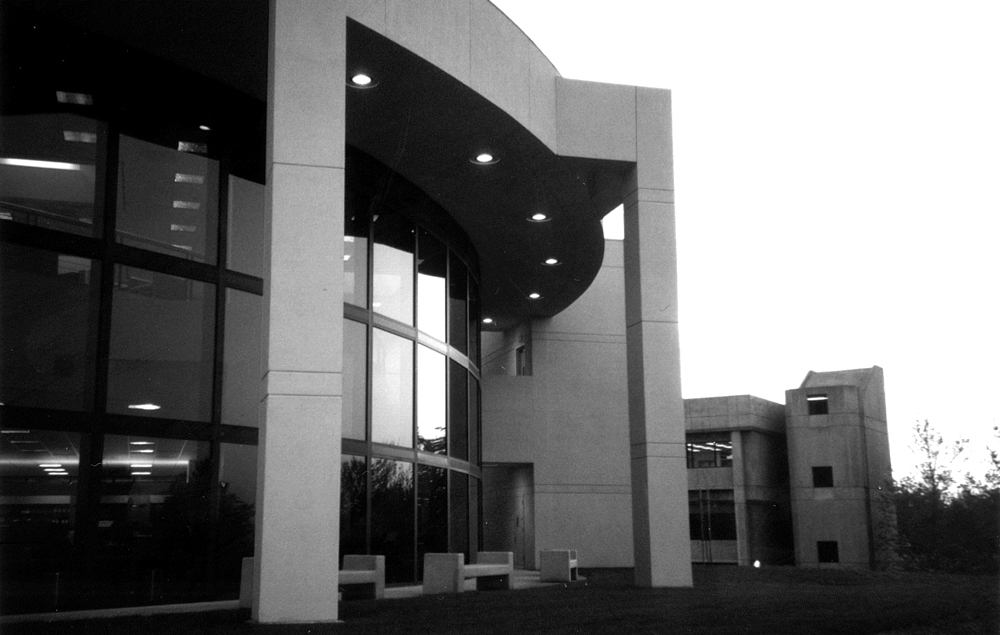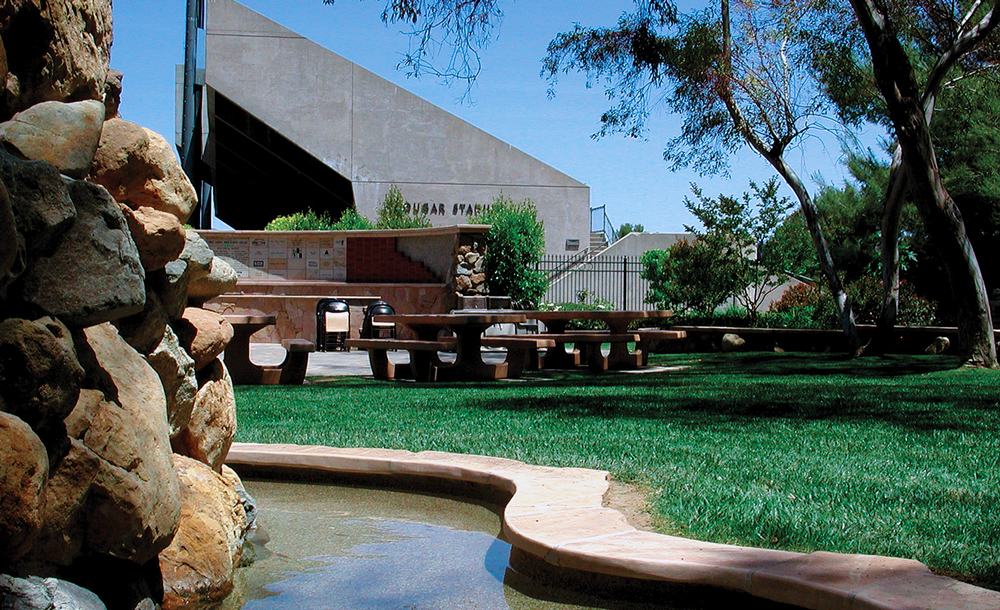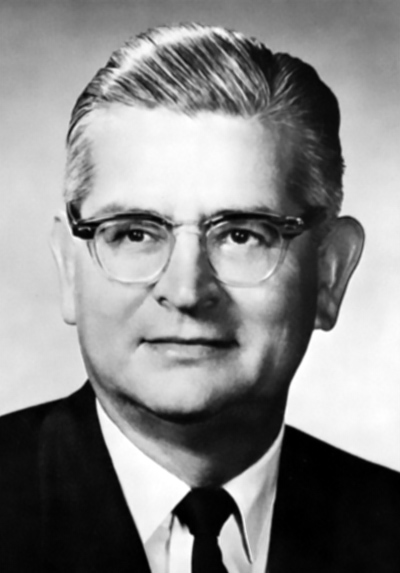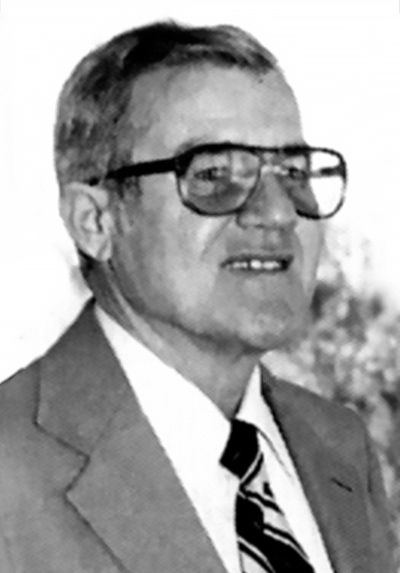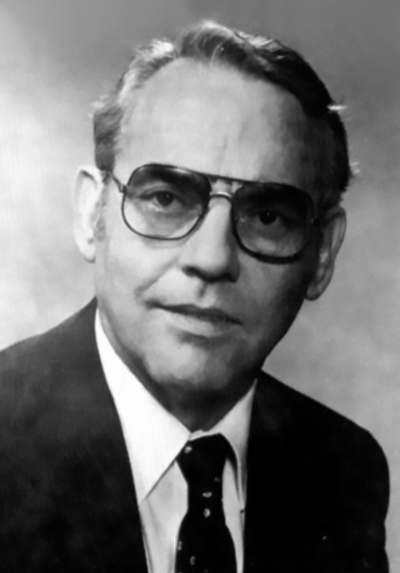50th Anniversary
Part 2
Part 1 | Part 2 | Part 3 | Part 4
Real Road, Imaginary Canyon
You won't find Rockwell Canyon on a local map. How then could a road be named after this imaginary gorge? For years, Mouck recalled, there was a stub of a road that extended from Valencia Boulevard to the college's staff parking lots. Newhall Land had plans to punch through the hills and extend the road to McBean Parkway, making it a natural extension of the existing Tournament Road near CalArts. College leaders, however, wanted a name that would honor the college's recently retired first superintendent-president, Dr. Robert C. Rockwell.
 "The county would not dedicate it as Rockwell Road because he was still living," Mouck said. He eventually convinced Newhall Land and Los Angeles County planners that the road should be called Rockwell Canyon Road - despite the glaring absence of a canyon named Rockwell. Mouck had found a way to honor his old boss - with a road that not only utilized his mentor's name, but shared the same initials: RCR.
"The county would not dedicate it as Rockwell Road because he was still living," Mouck said. He eventually convinced Newhall Land and Los Angeles County planners that the road should be called Rockwell Canyon Road - despite the glaring absence of a canyon named Rockwell. Mouck had found a way to honor his old boss - with a road that not only utilized his mentor's name, but shared the same initials: RCR.
By June of 1982, Mouck found himself once again filling in as the interim superintendent, following the resignation of Dr. Newcomer. He soon announced that his retirement was not long off. The one administrator who had been with the college since its inception set a departure date of Dec. 15, describing his 14 years at the college as a "labor of love."
Economic difficulties persisted at the start of the fall 1982 semester, with the college cutting 50 classes and experiencing an enrollment dip from 4,000 to 3,600 students.
Major League Baseball had its sights on the college's baseball program, which captured its first state title in 1981. This time, a trio of players was called up to the big leagues, pitcher Jeff Perry to the St. Louis Cardinals, and shortstop Jeff Hughes and outfielder Bill Gordon to the San Francisco Giants. Cougar baseball coach Mike Gillespie led the team to its second state title in May 1983 and was named coach of the year in both the state and nation.
On May 1, 1983, Dr. Ramon F. LaGrandeur became the third person to step into the role of superintendent-president of College of the Canyons. The former Spokane Community College president faced a daunting budget deficit of more than $473,000.
Free No More
The deficit was more than a local problem. With California bleeding red ink, the state's grand concept of providing a free college education to all citizens came to an end after 73 years. The state introduced a new requirement in 1984 that community college students pay enrollment fees of $5 per unit, up to a maximum of $50 per semester. Within a year, finances improved and the college began to return to normal. In 1985, work was completed on the college's long-awaited Physical Sciences Lab, and the chorus and jazz band regrouped after an absence of four years.
The year closed on a somber note, however, with the Nov. 9 death of popular biology professor Jim Boykin at the age of 59. A member of the college's first faculty, he taught at the college for 16 years. The science building was later renamed the James D. Boykin Lab Center (now, simply, Boykin Hall) in his honor.
In May, baseball coach Mike Gillespie wrapped up his 16th and final season, but not before the Cougars won their third state championship in six years with a remarkable 41-6 record - the most wins ever for a California community college. Gillespie's next stop would be USC.
Enrollment began to climb once again - if ever so slightly. Fall 1986 classes began with an increase of 50 students, indicating that perhaps the economy was improving, growth was at hand and better days were ahead.
The year 1987 was an important one for both the college and the community. Enrollment grew again, with some 3,700 students signing up for spring classes. The on-campus Sheriff's Department Training Academy graduated its first class of recruits - 57 men and six women - during a commencement ceremony attended by Sheriff Sherman Block and California Senator Ed Davis, former chief of the Los Angeles Police Department. And, the college's first Women's Conference, featuring KNBC News anchorwoman Kelly Lange as its keynote speaker, debuted to a sell-out crowd.
Dr. Dianne G. Van Hook is named the college's new superintendent-president during a press conference on May 16, 1988.
New Era Dawns
Perhaps most importantly for the burgeoning Santa Clarita Valley, 1987 was the year that signaled independence. When they went to the polls on Nov. 3, 69 percent of local voters supported the idea of creating the City of Santa Clarita, wresting control of much of the populated areas of the valley from Los Angeles County. The new city was the largest area to be incorporated in California history, and it became the second-largest city in size and the sixth-largest in population (130,000) within the county. Among the fledgling city's first City Council was Carl Boyer, a former member of the Santa Clarita Community College District Board of Trustees, the elected governing body of College of the Canyons.
Coinciding with the birth of this new city was a changing of the guard at the community's only public institution of higher learning. With five years under his belt as the college's top administrator, Dr. LaGrandeur retired in 1988, setting off a search for his successor.
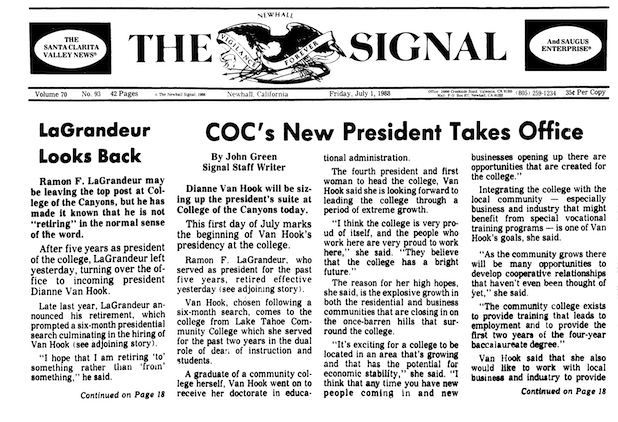 Stepping into the college's top spot was a new leader for a new era, a 37-year-old college administrator from the Lake Tahoe Community College District who was chosen from a field of 23 finalists. When Dr. Dianne Gracia Van Hook accepted the position, she became one of California's youngest superintendent-presidents.
Stepping into the college's top spot was a new leader for a new era, a 37-year-old college administrator from the Lake Tahoe Community College District who was chosen from a field of 23 finalists. When Dr. Dianne Gracia Van Hook accepted the position, she became one of California's youngest superintendent-presidents.
The progress that followed at College of the Canyons was nothing short of remarkable. Dr. Van Hook, herself a community college graduate from Long Beach, initiated the longest period of forward momentum in the college's history, extracting dollars from Sacramento and overseeing an expansion of educational facilities and programs that would stretch well into the next century.
Within a year, College of the Canyons held the distinction of being the fastest-growing community college in California, and Dr. Van Hook initiated an ambitious facilities master plan that would reshape the campus.
Growing Pains
By 1990, with some 6,500 students attending classes on a campus designed for 5,000, the college was beginning to experience the effects of overcrowding. It would be up to Dr. Van Hook to meet the challenge of accommodating the needs of a student population that was growing faster than anyone had imagined.
As the new decade began, College of the Canyons entered a period of its most significant growth and advancement since the original campus was built. Dr. Van Hook was given the mandate to take the college to the next level, with the ultimate goal of meeting the demands of a projected 20,000 students by the year 2010.
Dozens of new instructional and training programs were introduced. New instructors and staff members were brought on board. A helping, cooperative hand was extended to local government, business and industry. The college's master plan was updated to meet the current and projected demands of a community ranked as one of the nation's fastest growing.
Under a new brand of leadership, the atmosphere on campus was transformed into one of innovation, to pursue the dream of a community college that knows no boundaries.
But there were obstacles, the most significant being the state funding formula for fast-growing community colleges like College of the Canyons. The college's lifeblood was coming in at a comparative trickle considering the high rate of enrollment growth. In fact, the state's funding system penalized all of California's fast-growing community colleges. It was a state issue, and any changes to correct the funding system would have to be argued to legislators in Sacramento. It was with these realizations in mind that Dr. Van Hook and fellow college leaders crafted their strategy and, ultimately, the college's destiny.
Full Speed Ahead
What followed was a frantic lobbying schedule that put Dr. Van Hook, trustees and other college officials in Santa Clarita, Sacramento and points in between - often all in the same day to lobby for the cause. Eventually, with the help of state Sen. Ed Davis, legislation to correct the funding formula and boost revenue was enacted. State officials were persuaded to award millions of construction dollars the college needed to embark on a long-delayed expansion of facilities.
New facilities helped clear the way to boost the number of instructional and training courses by more than 50 percent - from 46 to 75 in a decade's time. The events that followed are best summed up as the biggest facilities expansion at College of the Canyons in a quarter century. Following the success of Proposition 153, a statewide school construction bond issue that earmarked $15 million to the college in 1992, the college embarked on a much-needed and long-overdue $56-million construction effort that produced a string of new buildings and expanded facilities.
First out of the gate was the 5,960-square-foot Family Studies & Early Childhood Education Center, whose groundbreaking was held in late 1993. Previously housed in the Administration Building (more commonly called the A Building), the working preschool and child development program had moved temporarily to Bowman High School in Canyon Country to make way for the relocation of the Admissions & Records Office.
Nineteen-ninety-three also was the year that the college began offering classes in Canyon Country, reflecting the emerging fact that most students resided in the eastern portion of the Santa Clarita Valley.
Tents serve as temporary classrooms following the 1994 Northridge Earthquake.
Earthquake Disrupts
Mother Nature interrupted everyone's plans in the early morning hours of Jan. 17, 1994. At 4:31 a.m., the 6.7-magnitude Northridge Earthquake hit, striking with such force than many of the college's classrooms were rendered uninhabitable. It was the first earthquake to strike directly under a major urban area of the United States since the 1933 Long Beach quake, and it rudely awakened most residents of the greater Los Angeles area.
At College of the Canyons, emergency-response teams gathered. The City of Santa Clarita had designated the college as an emergency operating and command center just a few years earlier. Although the college suffered major damage and was occupied by a veritable army of emergency services personnel, the start of the spring semester was delayed only one week. Many quake-damaged classrooms and buildings were not usable, so Dr. Van Hook enlisted Steve Myers, a foundation board member, to call President Bill Clinton's press secretary, his daughter DeeDee Myers (a graduate of Hart High School), for help. Within days, a village of tent classrooms was hastily erected on the athletic fields. In all, the college suffered some $3.4 million in damage.
Although the initial earthquake lasted just 15 seconds, its impact endured throughout the year. The California Conservation Corps sent a contingent of workers to the campus that summer to paint, plaster and secure furnishings as part of the overall quake cleanup. Students returning to the campus that fall found most of the repairs and reconstruction completed. Cougar Stadium and its running track reopened in September.
The campus was almost back to pre-earthquake condition when, on Sept. 22, the college kicked off its 25th anniversary with an academic convocation, complete with a processional of faculty, staff, administrators and invited dignitaries such as former Signal Editor Ruth Newhall and Santa Clarita Mayor George Pederson.
Building Plans Resume
The following year was one of remarkably quick recovery and institutional advancement. While earthquake repairs continued throughout the year, the college's focus was clearly on the future and moving the college forward. Evidence of this optimistic spirit could be seen during the groundbreaking ceremony for two new facilities: the Library and Media & Fine Arts Building (now called Mentry Hall). It was no accident that the ceremony was held on Jan. 17, the one-year anniversary of the devastating Northridge Earthquake. Even if only a psychological triumph, holding the event on this date sent a reassuring message that nothing - Mother Nature included - would stand in the college's way.
Even more tangible was the brand-new Family Studies & Early Childhood Education Center, which opened on a secluded southwest portion of the campus in April.
With enrollment beginning to climb again, attention turned to expanding student services. Among the new offerings were walk-in advisement in the Counseling Department, a crisis team and psychologist in the Student Health Center, and beefed-up occupational search services in the Career Center. In July of 1995, the college made its presence known on the World Wide Web by launching its first website. By year's end, 90 percent of the earthquake-recovery projects were completed.
The college continued its forward momentum in 1996. State funding - while still not commensurate with the college's growth - began to stabilize, allowing the college to expand its programs and open its doors to more students. The most visible sign of progress and new opportunity was construction activity on the new Library and the Media & Fine Arts Building, both of which were nearing completion.
In Boykin Hall, the lecture hall was renovated and transformed. Behind the rising Media & Fine Arts Building, an energy-efficient Central Plant went online, providing heating and air conditioning to both the Library and the Media & Fine Arts Building.
With campus recovery complete just two years after the Northridge quake, attention turned toward mitigating quake hazards in the future. More than $1.5 million in projects were identified to minimize future dangers, and the first $73,576 project began in December after being approved by FEMA and the Office of Emergency Services.
The new Library opened in 1997, as did the Media & Fine Arts Building (Mentry Hall).
New Buildings Open
Nineteen-ninety-seven began triumphantly in terms of college progress, as two important new buildings neared completion. The college gained more than 50,000 square feet of educational space when the Library and Media & Fine Arts Building (Mentry Hall) opened. The ribbons for both buildings were cut simultaneously on the symbolic date of Jan. 17, exactly three years after the Northridge quake.
Covering 27,222 square feet on two levels, the architecturally stunning Library - its curved walls of glass revealing a commanding view of the Santa Clarita Valley - opened its doors. The first floor held shelving for nearly 70,000 books, as well as reference material, casual seating and study space. The second floor contained audio-visual materials and listening stations, group-study rooms, a public gallery, an acquisitions/cataloging mall, periodicals, office space and more student seating. The building also boasted computer access to not just the library's holdings, but national and international databases.
Connected to the Library by a pedestrian bridge was the new Media & Fine Arts Building, designed to blend in with the architectural style of the original structures. Spanning 26,255 square feet on three floors, the building consolidated media and fine arts programs, including all visual arts, computer-assisted drafting, journalism and photography, and radio, television and cinema. The structure featured labs and support spaces, production and editing studios, a screening room, a lecture hall and an art gallery for public displays. Each level connected with the three main floors of the Instructional Resource Center. The buildings officially opened for business three months later.
"If you build it, they will come," a popular line from the film "Field of Dreams" suggested. And come they did. Student enrollment climbed once again, and the new buildings did more than alleviate campus crowding; they and a corresponding expansion of programs and classes beckoned even more to attend the college in 1997.
Expansion Continues
A greater infusion of long-sought growth funds translated into 139 new classes and a doubling of courses offered during the summer session. More than 2,700 students took summer classes, making it the highest-attended summer session at the time.
Campus expansion continued throughout 1997. Plans moved forward to remodel portions of Bonelli, Towsley and Boykin halls, and the Technology Center underwent a redesign to accommodate additional faculty and staff. In fact, enrollment growth and curriculum expansion throughout the college led to the hiring of more than 30 new employees. At that time, it was the largest number of people hired at the college in a single year.
Expansion of other services occurred in unique ways. The college and neighboring California Institute of the Arts agreed to split the cost of an online library automation system, and the Employee Training Institute opened its Valencia Learning Center to augment its educational contracts with local businesses.
It was a year of high performance, too. A comparison with California's then-107 other community colleges revealed that College of the Canyons ranked fourth highest in associate degrees awarded, fourth highest in occupational certificates awarded and 12th highest in terms of the number of students who transferred to Cal State University or University of California campuses.
Students were sticking around longer, as well. The college's student-retention rate improved from 74.8 percent in the fall of 1989 to 81.4 percent in the fall of 1996.
With two of the most extensive facilities expansion projects - the Library and Media & Fine Arts Building - completed, one might think construction would have abated by 1998. Not so. In fact, construction activity continued throughout the decade in an effort to meet the demands of ever more students and the new faculty and staff members who were needed to serve them. Construction was under way on six laboratories, 13 new classrooms, 18 offices, a conference room and an audio-video-computer technology area in 1998 alone. A state-of-the-art fitness center overlooking the basketball court was added inside the Physical Education Building.
The football program was revived in 1998 after an absence of 17 years.
Athletic Expansion
Expansion was occurring outside the classroom, as well. A new soccer field and practice fields were completed - and for good reason. This was the year athletic expansion arrived. The football program was revived after an absence of 17 years, and women's golf and soccer were introduced. The teams - football under the guidance of coach Chuck Lyon, soccer under Phil Marcellin and golf under Gary Peterson - enjoyed phenomenal success.
Strides were made in expanding educational offerings, too. Multimedia and fire-technology programs were introduced, and more classes were offered in subjects such as theatre, physical education, library, media, photography and radio-television.
High school students, meanwhile, recognized a good deal when they saw one. The college's waiver of enrollment fees for concurrently enrolled William S. Hart Union High School District students generated a 217 percent increase in numbers over fall 1997.
Perhaps one of the most significant accomplishments of the '90s was the positive shift in state funding for FTES (full-time equivalent students). A crucial factor in the financial woes of the 1980s and much of the 1990s was the state's withholding of FTES funding when it rose above a preset cap. By the 1997/98 academic year, the issue was largely moot, as unfunded FTES fell to zero.
"The upcoming years present an opportunity to do things at College of the Canyons that many colleges just dream about," Dr. Van Hook said at the start of the fall 1998 semester. "Will it be easy? Probably not. But to maximize our legacy to the future, meet the demands of our students and return value to our community, we must face challenges with optimism and action. And, we must all be accountable for what we do."
With Dr. Van Hook now having served College of the Canyons for 10 years, she emerged as a powerful advocate for every community college in the state. Recognizing the inequities of a state funding system that penalized all of California's rapidly growing community colleges, Dr. Van Hook was instrumental in persuading lawmakers to change the funding criteria in the colleges' favor. Her success in altering College of the Canyons' annual growth factor translated into a nearly $31 million net gain for the district over 10 years. From 1988 to 1998 she generated $56 million in additional revenue - money that College of the Canyons would not have received if not for her lobbying efforts. She secured a $75 million commitment from the Chancellor's Office for campus expansion over a 10-year period. And, in the 1992-93 state budget she won reinstatement of construction projects valued at $70 million for 13 community college districts across California.
Enrollment Hits 10,000
A milestone in 1999 came sooner than the state predicted, but it came as no surprise to anyone at College of the Canyons. This was the year that student enrollment crested the 10,000 mark - 10,260, to be precise. It was the second consecutive year of quadruple-digit growth, with both years representing the greatest single-year increases in the number of enrolled students. Although it was unlikely that all 10,260 students would be on campus at any one time, elbow room was definitely at a premium. The signs of growth were everywhere - more students, crowded classrooms and even more crowded parking lots, piles of earth and equipment to mark various construction sites on campus. Despite all of the impressive new facilities that had opened, the campus was literally bursting at the seams.
Facilities expansion continued unabated in 1999. The most visible was the activity at the Student Center, one of the college's original buildings. Work continued throughout the year to remodel 15,000 square feet of classroom and office space, as well as add an extra 9,000 square feet to create an enclosed lounge area, increase the size of the student dining room and bookstore, and build additional classroom space and offices.
Another 10,000 square feet of temporary classroom space arrived in the form of seven modular buildings - collectively called the Modular Classroom Village and located at the southern end of the campus. This complex housed 14 much-needed new classrooms, as well as the first bachelor's degree programs offered on campus, made possible through an innovative partnership with Cal State Bakersfield and the University of La Verne. It was, in fact, the precursor to an even more ambitious project known as the University Center, for which planning had begun.
The Cougar Den, built entirely with private donations, opened in 1999.
Innovation Triumphs
The idea behind this educational center on College of the Canyons property was for other colleges and universities to offer upper-division programs here, eliminating the need for Santa Clarita Valley residents to travel elsewhere to earn degrees. The vast distances to four-year universities - as well as the excessive driving time it took to get there and back - had been identified as major obstacles to higher education. The University Center would change that for the better. Its popularity grew to the point where an interim facility to house its degree programs opened in early 2002 to meet demand.
Enlisted to head the $10-million fundraising campaign to build a permanent facility for this major endeavor were Tom Lee, who had recently retired from his position as CEO of The Newhall Land & Farming Co., and Lou Garasi, chairman and CEO of Gruber Systems.
The University Center wasn't the only educational partnership on campus. The college and William S. Hart Union High School District together took a bold step forward as Dr. Van Hook pursued state funding to add a high school campus on college property. To be called Academy of the Canyons, this "middle college" concept would allow high-potential high school students to attend high school and college concurrently, giving them a significant jump on their future academic or work careers.
Also opening in 1999 was the Cougar Den, a lush, tree-shaded spot with picnic tables, barbecues and room to roam. Located next to Cougar Stadium, the project was conceived by football coach Chuck Lyon, COC Foundation board member and alumnus B.J. Atkins, and contractor Jim Keltner. The facility was built entirely with private donations. In all, some 200 people contributed money or services to build it.
Grant money surpassed the million-dollar mark, coming in at just more than $1.2 million. The money would be used to help establish Academy of the Canyons; launch the MESA (Math Engineering Science Advancement) program to encourage more students to consider majors and careers in science, engineering and math-based fields; and to continue developing programs in manufacturing, engineering and computer networking.
Green Light for Performing Arts
The Performing Arts Center also moved forward. Identified in the college's original master plan in 1969, the Performing Arts Center was to have been built toward the end of the college's first full decade, but funding failed to materialize because the state insisted that such facilities were neither necessary nor essential. Nevertheless, the college kept the dream alive by identifying a performing arts center as an essential part of the campus, and Dr. Van Hook continued to lobby the state for funding.
With the college poised for any opening to build the center, an opportunity presented itself in 1999. State officials called to say that if the college could separate plans for the theater from the music-dance instruction areas, the performing arts center could indeed be built. But this window of opportunity would close in just 36 hours. The state agreed to fund the center after college staff members and the center's architects reworked the architectural plans by the deadline.
Finally, construction of the long-awaited Performing Arts Center was just around the corner - and it would be even more grand than originally envisioned. The state disbursed money to begin the planning process, and the City of Santa Clarita committed $2.4 million in March 2000 to dramatically expand the center's capacity - from 400 to nearly 900 seats. The partnership would transform the center into one that could be enjoyed by the entire community.
As the new millennium dawned, College of the Canyons experienced some pivotal events. Indeed, the pace of progress actually quickened and gained added significance through the first half of the new decade.
The remodeled and expanded Student Center opened that summer of 2000, featuring a dramatic new entry and atrium, a larger dining room and more space for programs such as health services and student development. The first classes began at Academy of the Canyons with 138 students. And, the men's golf team captured its second state championship, the first being seven years earlier.
As enrollment soared, the student parking lots revealed their limitations. The decision was made to build the South Parking Lot, a project outlined in the first master plan but deemed unnecessary until this point. Construction began in early 2001, with most of the $8 million project completed in time for the start of the fall semester. Students found 1,000 additional parking spaces, most of them closer to the buildings that housed their classes; another 600 were made available later in the year.

 My Canyons
My Canyons  Canvas
Canvas 
